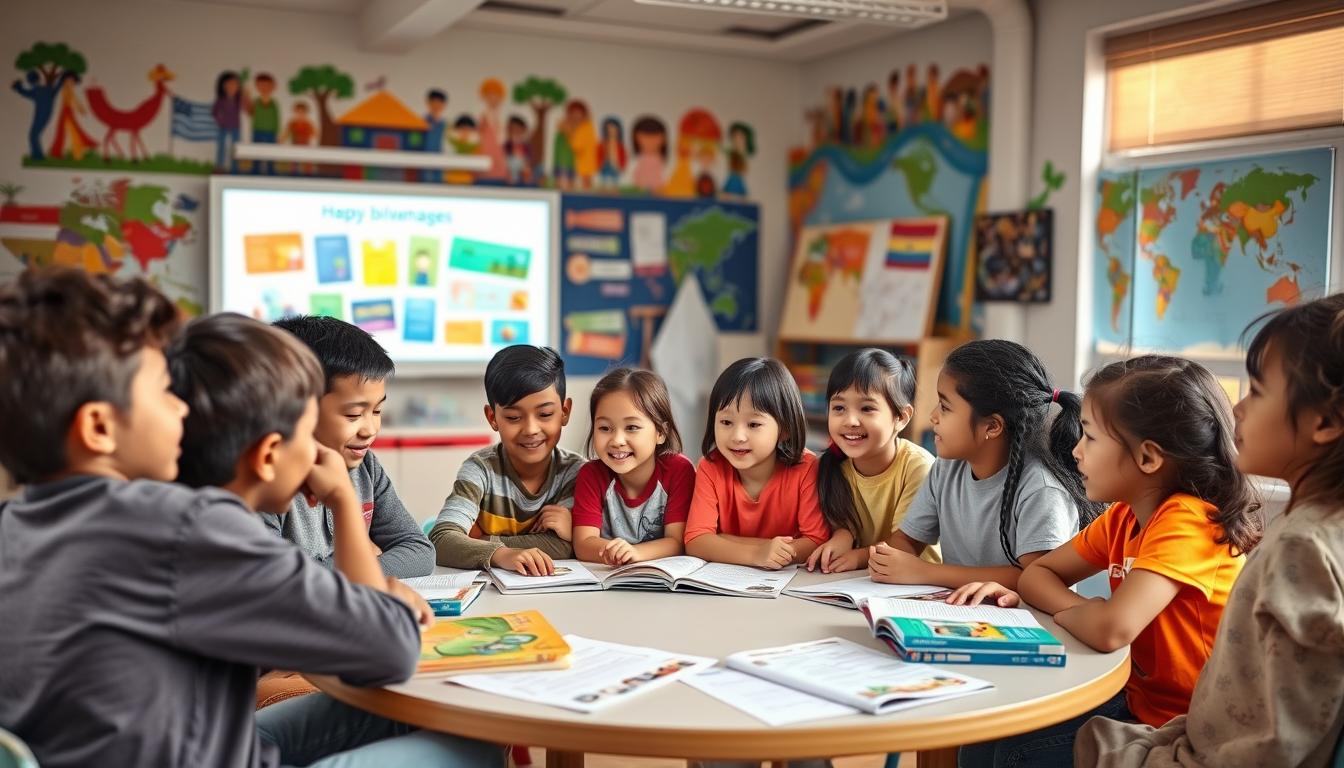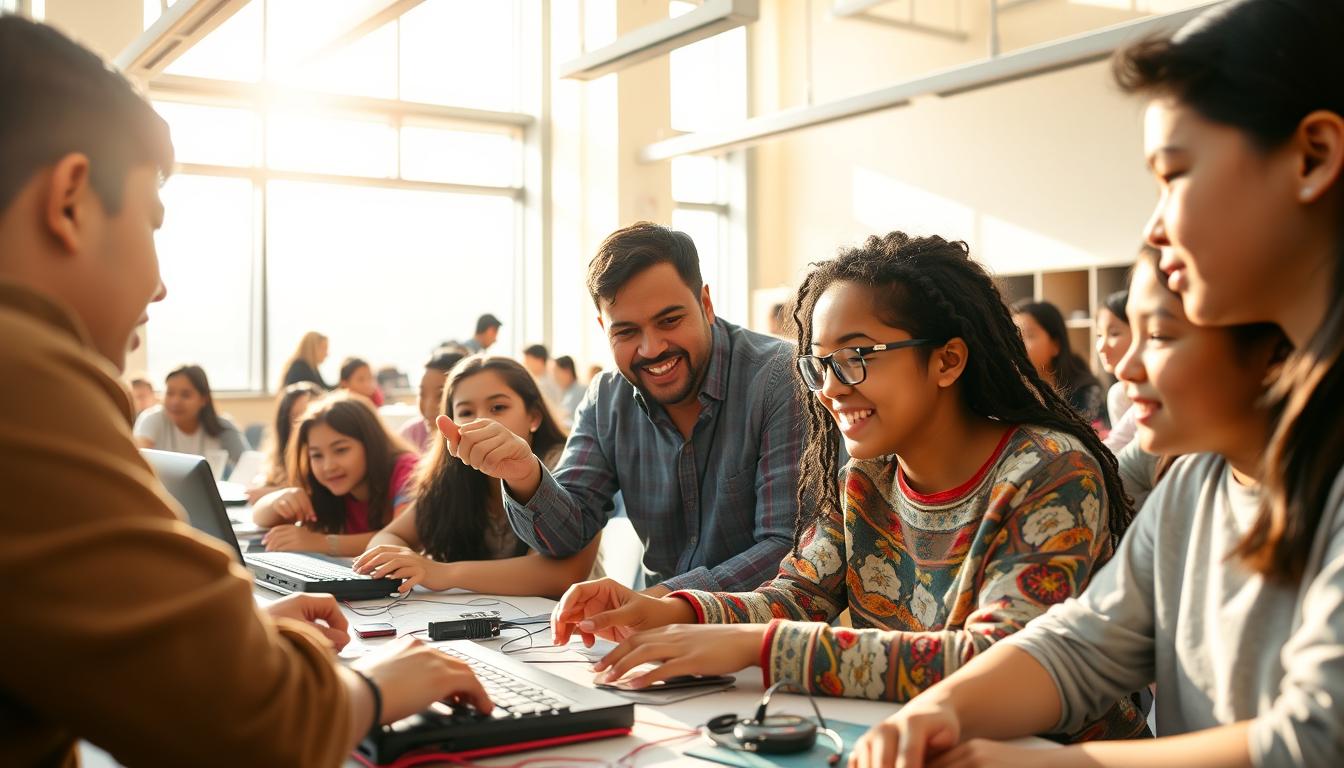Fostering Educational Partnerships: Collaborative Efforts to Enhance Learning for Immigrants
In today’s diverse society, Educational Partnerships are key to helping immigrant communities. These partnerships offer resources and support that meet the needs of learners from different backgrounds. By working together, schools can create a welcoming place for everyone.
This approach not only helps immigrants fit into the educational system but also boosts cultural understanding. It makes learning better for students and teachers alike. This shows how important teamwork is in education.
Importance of Educational Partnerships in Immigrant Communities
Educational partnerships are key in helping immigrant communities. They tackle challenges like language barriers and cultural differences. They also help with psychosocial issues. This collaboration improves the learning experience for immigrant students.
Overview of Immigrant Education Needs
It’s vital to understand the education needs of immigrants. Support should be tailored to their language skills and cultural backgrounds. This way, schools can create better learning spaces for everyone.
Key Statistics on Immigrant Learners
Statistics show why focusing on immigrant learners is important. About 1 in 4 public school students in the U.S. are immigrants or children of immigrants. This highlights the need for educational strategies that meet their needs.
Benefits of Collaboration in Education
Collaboration among schools, nonprofits, and community groups offers many benefits. By sharing resources and expertise, they can create better programs for immigrant students. This teamwork helps students feel part of a community and boosts their engagement in learning.
Types of Educational Partnerships
There are many types of educational partnerships that help immigrant learners. Each one has its own benefits and resources. They all play a big role in the education world.
Public-Private Partnerships
Public-private partnerships are great for linking schools with businesses. They help create internships and vocational training. This way, students get real-world experience and learn about different careers.
Nonprofit and Educational Institution Alliances
Nonprofits team up with schools to help students. They offer scholarships and mentorship. This support helps immigrant students succeed and grow.
Community-Based Organization Collaborations
Community collaborations bring together local groups to support immigrant families. They focus on building capacity, hosting cultural events, and running workshops. This support goes beyond just school and helps learners in many ways.
Successful Models of Educational Partnerships
Education partnerships show great promise for improving learning for immigrants. Local teams, especially in cities, tackle specific immigrant challenges well. They make learning spaces where everyone feels welcome and involved.
Case Study: Local Collaborations in Urban Areas
Places like Los Angeles and Chicago are great examples of local teamwork. They focus on teaching in multiple languages, helping families and schools work together. These efforts show how partnerships can make a real difference.
Innovations from Global Partnerships
Global partnerships bring new ideas to education. Groups like UNESCO help countries share best practices. This sharing helps improve learning for immigrant students everywhere.
Best Practices from Leading Educational Institutions
Top schools like Harvard and Stanford have great methods for helping immigrant students. They use personalized learning plans and flexible curricula. These approaches show how partnerships can succeed in many places.
Challenges in Creating Effective Partnerships
Creating strong educational partnerships is tough. Many hurdles must be overcome. These issues can really impact the success of programs for immigrant communities.
Funding and Resource Limitations
Many partnerships face funding problems. This limits their ability to run full programs. Relying on grants and donations can be risky. It makes it hard to keep projects going for a long time.
Without steady money, important projects often can’t reach their goals.
Cultural and Linguistic Barriers
Cultural differences can make it hard for educators and immigrant families to talk. Not understanding each other can cause big problems. It can lead to confusion about school rules and goals.
Linguistic barriers also get in the way. They make it hard to work together and succeed in education.
Commitment and Engagement Issues
Stakeholders’ commitment can vary, causing problems. When people don’t share the same goals, it can mess up plans. It’s also a challenge when people can’t give enough time or resources.
Working on these issues is key to a strong education and support system.
Strategies for Building Thriving Educational Partnerships
Creating effective educational partnerships needs careful planning and teamwork. It starts with finding key players in the community and schools. This makes sure everyone’s voice is heard, especially from immigrant families. A solid base helps everyone work together better, supporting learning efforts.
Identifying Stakeholders and Key Players
Building a strong partnership begins with knowing who’s important. This group includes:
- Schools and educational institutions
- Community organizations
- Local government agencies
- Immigrant families and advocacy groups
Knowing these stakeholders helps in planning together and making decisions.
Developing Clear Goals and Objectives
It’s key to have clear goals and objectives for teamwork to work well. Try to set:
- Specific goals for educational programs
- Deadlines for these goals
- What each partner will do
Clear goals help everyone stay on track and see how they’re doing.
Establishing Communication Channels
Good communication builds trust and keeps things open. Setting up clear ways to talk helps everyone stay in the loop. You might use:
- Email newsletters
- Community meetings or forums
- Dedicated project management tools
Talking regularly keeps everyone involved and helps partnerships last.
Role of Technology in Enhancing Partnerships
Technology is key in making educational partnerships work, especially for immigrant learners. It helps in sharing resources and working together better. This leads to better learning outcomes. It’s important to know how to use technology to help different communities.
Online Platforms for Collaboration
Online tools are now crucial for partnerships. They let people talk and share things in real time. This makes it easier to work together and solve problems, which helps immigrants learn better.
E-Learning Tools for Diverse Learners
E-learning helps immigrants get the education they need, no matter where they are. It lets people learn at their own speed. This helps immigrants overcome learning challenges and get education easily.
Virtual Networking and Resource Sharing
Virtual networking has changed how partners connect. Online events and forums help share knowledge and support. Sharing resources online saves time and makes partnerships more effective for immigrant education.
Government Initiatives Supporting Educational Partnerships
Government programs are key in helping educational partnerships grow across the U.S. They work together at all levels to support immigrant students. This teamwork ensures students get the help they need.
Federal Programs Promoting Collaboration
Programs like Title III funding from the U.S. Department of Education help a lot. They give schools the tools to improve English skills and grades. This support is crucial for students who are new to English.
State-Level Initiatives and Funding Opportunities
States focus on partnerships between schools and community groups. They offer grants to help schools work better with families and organizations. This way, schools can create programs that respect different cultures and include everyone.
Local Government Efforts to Aid Immigrant Education
Local governments are also very important. They set up committees to help with immigrant education. These groups work together to meet community needs, focusing on language, culture, and school support.
Measuring the Impact of Educational Partnerships
To see if educational partnerships work, we need to measure their impact carefully. It’s important to set clear goals for what we want to achieve. This helps us understand how these partnerships help immigrant students and improve education for everyone.
Metrics for Success
Success in educational partnerships is measured in different ways. Here are some common ones:
- Student performance indicators, such as grades and test scores
- Retention rates, showing how many students keep going to school
- Graduation statistics, which tell us how many students finish their programs
Collecting and Analyzing Data
Good data analysis is key to making partnerships better. We collect both numbers and stories to learn more. Surveys, tests, and reports help us see what’s working and what needs work.
Reporting Outcomes to Stakeholders
Telling everyone about the results builds trust and keeps people involved. Sharing how partnerships are doing helps everyone stay on board. This openness makes sure everyone keeps supporting and joining in.
Cultural Competence in Educational Partnerships
Cultural competence is key in educational partnerships, especially in diverse classrooms. It helps educators understand and value the backgrounds of immigrant students. This approach makes learning inclusive for everyone, improving the educational experience.
Importance of Understanding Diverse Backgrounds
Knowing the cultural backgrounds in the classroom helps educators adjust their teaching. This awareness creates a respectful and inclusive learning space. It also helps educators connect better with their students, leading to better grades.
Training Programs for Educators and Partners
Training educators is vital for cultural competence. Workshops and professional development help them support immigrant families. These programs teach about cultural differences, communication, and teamwork, boosting educational partnerships.
Strategies for Inclusive Curriculum Development
Creating an inclusive curriculum meets the needs of all students. It involves using materials that reflect immigrant learners’ backgrounds. Strategies include using multilingual resources, diverse perspectives, and encouraging student discussions.
Engaging Families in Educational Partnerships
Family engagement is key in making educational partnerships work, especially in diverse communities. It’s important to communicate well with all family members to make them feel included. Schools and organizations that involve families build stronger support systems.
Communication Strategies for Diverse Families
Creating effective communication plans is vital for reaching out to diverse families. This can include:
- Providing multilingual resources to break down language barriers.
- Using visual aids and interactive methods during meetings.
- Hosting community forums for open dialogue.
Encouraging Family Participation in Education
Getting families involved in education makes learning better for students. Schools can start initiatives like:
- Workshops to help families understand the curriculum.
- Open houses to explore school resources and activities.
- Parent-teacher conferences that welcome feedback.
Support Resources for Families of Immigrants
Offering support to immigrant families helps them navigate the education system. Important resources include:
- Language assistance programs for communication with educators.
- Cultural orientation sessions to understand the U.S. education system.
- Access to community organizations for extra support.
Future Trends in Educational Partnerships
As educational partnerships evolve, new trends are emerging. Artificial intelligence in education is becoming more important. It offers tailored learning experiences, especially for immigrant students who need special support.
Adaptive learning technologies can address individual needs in real time. This changes how educational partnerships work.
Growing Role of Artificial Intelligence
Artificial intelligence in education has great potential. It helps teachers give immigrant students the right resources for their learning paths. AI tools can spot knowledge gaps, making instruction more effective for each student.
This could be a big change in educational partnerships.
Trends in Community Engagement
Community engagement is moving towards more teamwork. Local groups and communities want better education for immigrant families. This shows the need for both school support and community involvement.
These partnerships are expected to build stronger ties between schools and families.
Predictions for Policy Changes
Policy changes are expected to make education more inclusive. Laws might focus on fairness, ensuring all students, including immigrants, get equal learning chances. Educational partnerships will need to adjust to these changes.
They must be able to adapt to meet new societal needs and promote inclusivity.
Conclusion: The Future of Educational Partnerships
The future of educational partnerships is full of promise for immigrants’ learning. A summary of these partnerships shows how collaboration can make a big difference. When everyone works together, they can tackle the unique challenges immigrants face.
This teamwork can lead to better access to education and fairness for all. It’s a chance to make learning better for everyone.
Stakeholders need to step up and support these partnerships. Teachers, groups, and leaders should give their time, skills, and resources. This will help build strong networks focused on helping immigrants.
Working together not only helps immigrants but also makes communities better. It’s a win-win for everyone.
As we move forward, making sure all students get the same chance to learn is key. Educational partnerships help create places where everyone can grow and succeed. This way, we can build a fairer and stronger society for all.
FAQ
What role do educational partnerships play in supporting immigrant learners?
How can schools effectively engage families in educational partnerships?
What types of educational partnerships exist to support immigrant education?
What are some common challenges faced in creating educational partnerships?
How can technology enhance educational partnerships for immigrant learners?
What government initiatives support educational partnerships for immigrants?
How can the impact of educational partnerships be measured?
Why is cultural competence important in educational partnerships?
What strategies are effective for building thriving educational partnerships?
What future trends are expected in educational partnerships for immigrant education?
Published on: 28 de March de 2025

Luke Martin
Luke Martin, author of Credwallets.com, is a mathematics graduate with a specialization in financial markets. Known for his love of pets and his passion for sharing knowledge, Luke created the site to provide valuable insights into the complexities of the financial world. His approachable style and dedication to helping others make informed financial decisions make his work accessible to all, whether they're new to finance or seasoned investors.







